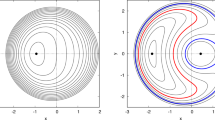Abstract
A simple mechanical model explaining the long-period (about 100-year) variations in the Earth’s rotational velocity is proposed. This model takes into account the gravitational interaction of the mantle with the solid core of the Earth and the fact that the core rotation leads that of the mantle. Well-known Earth parameters provide estimates of the gravitational torque that support the proposed model. The mathematical problem involved reduces to the classical problem of a nonlinear oscillator exposed to a constant torque. The well-known parameters of the core-mantle system result in a stable equilibrium and a stable limiting cycle on the phase cylinder of this oscillator. This equilibrium corresponds to a single angular velocity for the mantle and solid core, with no long-period oscillations in the length of the day. The limiting cycle corresponds to the core rotation leading the mantle rotation. In this case, the ellipsoidality of the gravitationally interacting bodies provides a periodic interchange of kinetic angular momentum between the mantle and solid core that results in long-period variations in the length of the day. The proposed model does not support the formerly widespread opinion that the core rotates more slowly than the mantle.
Similar content being viewed by others
References
X. Song and R. G. Richards, Nature 382, 221 (1996).
V. M. Ovchinnikov, V. V. Adushkin, and V. A. An, Dokl. Akad. Nauk 362, 683 (1998).
G. G. Denisov and V. V. Novikov, Dokl. Akad. Nauk 362, 484 (1998) [Phys. Dokl. 43, 630 (1998)].
L. D. Landau and E. M. Lifshitz, Course of Theoretical Physics, Vol. 6: Fluid Mechanics (Nauka, Moscow, 1986; Addison-Wesley, Reading, 1959).
B. G. Bills, J. Geophys. Res. 104, 2653 (1999).
F. H. Busse, Ann. Rev. Fluid Mech. 10, 435 (1978).
A Physical Encyclopaedic Dictionary in Five Volumes (Sovetskaya Entsiklopedia, Moscow, 1962), vol. 2 [in Russian].
A. S. Monin, Earth’s Rotation and the Climate (Gidrometizdat, Leningrad, 1972; Radhakrishna Prakashan, Delhi, 1974).
Excess of the Duration of the Day over 86400S and Angular Velocity of the Earth’s Rotation since 1623, http://hpiers.obspm.fr/eoppc/earthor/ut1lod/lod-1623.html.
G. G. Denisov, V. V. Novikov, and A. E. Fedorov, Dokl. Akad. Nauk 400, 625 (2005) [Phys. Dokl. 50, 95 (2005)].
A. A. Andronov, A. A. Vitt, and S. E. Khaikin, Theory of Oscillators (Fizmatgiz, Moscow, 1959; Pergamon, Oxford, 1966).
Additional information
Original Russian Text © G.G. Denisov, V.V. Novikov, A.E. Fedorov, 2008, published in Astronomicheskiĭ Zhurnal, 2008, Vol. 85, No. 12, pp. 1143–1150.
Rights and permissions
About this article
Cite this article
Denisov, G.G., Novikov, V.V. & Fedorov, A.E. Gravitational interactions of the solid core and the Earth’s mantle and variations in the length of the day. Astron. Rep. 52, 1027–1034 (2008). https://doi.org/10.1134/S1063772908120081
Received:
Accepted:
Published:
Issue Date:
DOI: https://doi.org/10.1134/S1063772908120081




